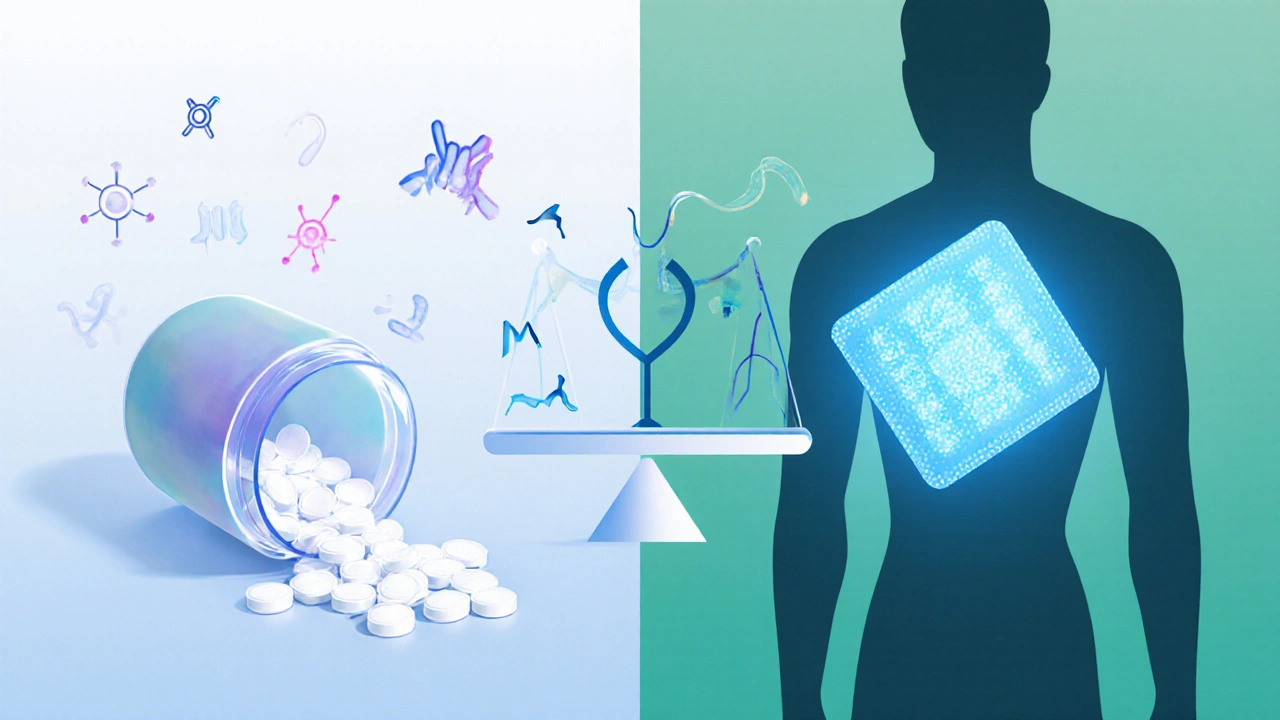Emsam vs. Alternatives: Depression Medication Comparison Tool
Selected Medication Details
Priority-Based Recommendations
Emsam is a trans‑dermal patch that delivers selegiline, a selective MAO‑B inhibitor, directly through the skin for the treatment of major depressive disorder. Unlike oral formulations, the patch bypasses first‑pass metabolism, which can reduce certain dietary restrictions and side‑effects. The patch is applied once daily and releases a steady dose over 24hours, providing a smoother plasma level compared with pills.
How the Emsam Patch Works
Selegiline blocks the enzyme monoamine oxidase‑B, preventing the breakdown of dopamine, norepinephrine and serotonin. By raising the concentration of these neurotransmitters, mood improves. The trans‑dermal delivery allows a low systemic dose (typically 6mg/24h) to achieve therapeutic levels in the brain while keeping peripheral MAO‑A inhibition minimal. This design reduces the classic "cheese effect" - dangerous hypertensive crises caused by tyramine‑rich foods.
Key Attributes of the Patch
- Formulation: 6mg/24h or 9mg/24h adhesive patch
- Route: Skin (trans‑dermal)
- Typical dosing: One patch applied to a clean, dry area of the upper torso or back, replaced every 24hours
- Onset of action: 1-2 weeks for noticeable mood improvement
- Approval: FDA‑approved for major depressive disorder (MDD) in the United States; EMA approval for Parkinson’s disease, off‑label use in the UK for depression
- Common side‑effects: Skin irritation, insomnia, headache, dizziness
- Major drug interactions: Other MAO inhibitors, certain SSRIs/SNRIs (risk of serotonin syndrome)

Alternative Options to Consider
When weighing Emsam against other treatments, it helps to break alternatives into three buckets: other MAO‑B inhibitors, standard antidepressants, and non‑pharmacologic strategies.
Selegiline oral is the same active molecule taken as a tablet (usually 5-10mg daily). It shares the MAO‑B inhibition profile but re‑introduces dietary restrictions at higher doses because the gut sees the drug before it reaches the brain.
Rasagiline is another selective MAO‑B inhibitor, marketed mainly for Parkinson’s disease (1mg daily). Small trials show it can improve depressive symptoms with fewer dietary constraints, but it is not officially licensed for MDD in most European countries.
Safinamide adds reversible MAO‑B inhibition plus dopamine release modulation. Approved for Parkinson’s, it has emerging evidence for treating depression, yet the cost is higher and availability limited.
Sertraline (an SSRI) and Venlafaxine (an SNRI) represent the most commonly prescribed first‑line antidepressants. They work by directly increasing serotonin (SSRI) or both serotonin and norepinephrine (SNRI). Their side‑effect profiles differ-sexual dysfunction for SSRIs, increased blood pressure for SNRIs-but they have no MAO‑related dietary warnings.
Bupropion is a norepinephrine‑dopamine reuptake inhibitor (NDRI) that can energize patients who feel "flat" on serotonergic agents. It does not trigger serotonin syndrome and has a lower risk of sexual side‑effects, though it can raise seizure risk at high doses.
Side‑by‑Side Comparison Table
| Medication | Formulation | Route | Typical Dose | Depression Indication | Onset (weeks) | Common Side‑effects | Major Interactions | Approx. UK Cost per Month |
|---|---|---|---|---|---|---|---|---|
| Emsam (Selegiline Patch) | 6mg/24h or 9mg/24h patch | Trans‑dermal | 1 patch daily | Off‑label (UK), FDA‑approved US | 1-2 | Skin irritation, insomnia, headache | Other MAO‑Is, SSRIs/SNRIs (serotonin syndrome) | ~£85‑£110 |
| Selegiline Oral | 5mg or 10mg tablet | Oral | 5‑10mg daily | Off‑label UK, FDA‑approved US | 2-4 | Nausea, dizziness, dietary tyramine restrictions at >10mg | MAO‑Is, sympathomimetics | ~£30‑£45 |
| Rasagiline | 1mg tablet | Oral | 1mg daily | Off‑label for depression (limited evidence) | 2-3 | Dizziness, headache | Other MAO‑Is, serotonergic drugs | ~£70‑£90 |
| Sertraline (SSRI) | Tablets 25‑200mg | Oral | 50‑200mg daily | First‑line MDD | 3-6 | Sexual dysfunction, GI upset | MAO‑Is (serotonin syndrome) | ~£12‑£20 |
| Venlafaxine (SNRI) | Capsules 37.5‑225mg | Oral | 75‑150mg daily | First‑line MDD | 3-6 | Increased BP, nausea, insomnia | MAO‑Is, other serotonergic agents | ~£15‑£25 |
| Bupropion (NDRI) | Tablets 150‑300mg | Oral | 150‑300mg daily | Adjunct or switch for MDD | 2-4 | Dry mouth, insomnia, seizure risk at high dose | MAO‑Is (minor), other stimulant‑type meds | ~£25‑£35 |
Pros and Cons at a Glance
Why you might choose Emsam
- Steady drug delivery reduces peaks and troughs.
- Lower risk of severe dietary tyramine reactions at therapeutic doses.
- Convenient once‑daily application for patients who dislike swallowing pills.
Potential drawbacks
- Higher upfront cost compared with generic oral tablets.
- Skin irritation can be a deal‑breaker for some.
- Limited UK licensing means you’ll likely need a private prescription.
In contrast, oral MAO‑B inhibitors are cheaper but bring back the classic cheese‑effect warning at higher doses. SSRIs and SNRIs are inexpensive and widely covered by the NHS, yet they carry risks of sexual dysfunction and weight gain, and they may be less effective for patients with prominent anhedonia that responds better to dopaminergic‑acting drugs like selegiline.
How to Decide Which Option Fits You
Ask yourself these practical questions:
- Do you have trouble swallowing pills? The patch excels here.
- Are you on a strict diet or live in a setting where tyramine‑rich foods are common? Emsam’s lower systemic MAO‑A activity can ease that concern.
- What’s your budget? If cost is the main driver, oral generics or NHS‑prescribed SSRIs usually win.
- Do you need rapid symptom relief? Some patients report faster mood lifts with dopaminergic agents, but evidence is mixed. Trial periods of 4-6 weeks are typical.
- Any history of skin allergies? Patch‑related dermatitis is a real possibility.
Discuss these points with your GP or psychiatrist. They can run a brief screen for MAO‑I contraindications (e.g., use of sympathomimetic decongestants) and tailor the regimen.
Practical Tips for Using the Emsam Patch
- Apply to clean, dry skin on the upper torso or back; rotate sites each day to avoid irritation.
- Wash hands after handling the patch; avoid touching eyes or mouth.
- Never cut the patch - it will alter dose delivery.
- Store unused patches at room temperature, away from heat sources.
- If you miss a day, apply a new patch as soon as you remember; do not double‑dose.
Frequently Asked Questions
Can I eat cheese while using the Emsam patch?
At the standard 6mg/24h dose, the risk of hypertensive crisis from tyramine‑rich foods is very low. Most clinicians advise normal diet, but it’s still wise to avoid excessive amounts of aged cheeses, cured meats, or fermented products.
How does the efficacy of Emsam compare to an SSRI like sertraline?
Head‑to‑head trials are limited, but meta‑analyses suggest similar remission rates for moderate‑to‑severe depression. Emsam may work faster for patients whose symptoms are linked to low dopamine, while SSRIs excel in classic serotonergic profiles.
Is the Emsam patch covered by the NHS?
Generally, no. The patch is not on the NHS formulary for depression, so patients usually need a private prescription or pay out‑of‑pocket.
What should I do if I develop a rash under the patch?
Remove the patch immediately, clean the area with mild soap, and contact your prescriber. They may switch you to an oral MAO‑B inhibitor or another class of antidepressant.
Can I combine Emsam with other antidepressants?
Combination therapy is possible but must be supervised closely. Adding an SSRI or SNRI increases the risk of serotonin syndrome, so dose adjustments and monitoring are essential.
Whether you end up on a patch, a pill, or a combination, the key is to match the treatment to your symptoms, lifestyle, and financial situation. Keep an open dialogue with your healthcare team, track how you feel week by week, and don’t be afraid to ask for a switch if something isn’t working.






Comments
Meredith Blazevich
6/Oct/2025I totally get how overwhelming the choice between a patch and a pill can feel, especially when you’re dealing with depression and trying to keep daily routines simple. The patch’s once‑daily application can really reduce the hassle of remembering multiple doses, which is a big win for anyone with low motivation. At the same time, the upfront cost might make you hesitate, but many find the steadier drug delivery worth the investment. If skin irritation is a concern, rotating the site each day can help minimize rash risk. Ultimately, matching the medication to your lifestyle and budget is key, and a chat with your prescriber can clear up a lot of the doubts.
Nicola Gilmour
6/Oct/2025Switching to a patch can feel like a small victory against daily pill fatigue.
Darci Gonzalez
6/Oct/2025When you’re navigating the maze of depression meds, the Emsam patch often shows up as a bright, if pricey, beacon. It delivers selegiline right through the skin, which sidesteps the first‑pass metabolism that oral pills suffer from. That means you get a smoother, more consistent blood level without the peaks and valleys that can make moods swing wildly. The lower risk of the infamous “cheese effect” is also a huge relief for folks who love their cheeses and don’t want to count every crumb. Sure, the cost can feel steep-£85 to £110 a month isn’t pocket change-but for many the convenience outweighs the price tag. Skin irritation is the most common complaint, yet rotating the patch site daily usually keeps it at bay. The patch also sidesteps the swallowing issue, which many patients with depression struggle with due to low motivation. Onset is relatively quick too, often within one to two weeks, so you don’t have to wait months to feel a shift. Comparing it to sertraline, the patch can be a better fit when dopamine‑related apathy dominates the picture. If you’re already on an SSRI and worried about serotonin syndrome, a careful wash‑out period is essential before starting the patch. Many clinicians will start at the lower 6 mg dose to gauge tolerance before bumping up. The patch’s discreet nature can also be a social perk-no one sees you taking medication in a public restroom. However, the private‑prescription route in the UK may add another layer of bureaucracy. It’s wise to discuss insurance coverage or potential discount programs upfront. Some patients report better sleep patterns on the patch, while others notice a slight increase in insomnia-monitoring your sleep is key. Finally, always keep an eye on blood pressure and any sudden headaches, as these can hint at interactions with other meds you might be on. In the end, the decision should balance efficacy, side‑effect profile, convenience, and your personal budget.
Marcus Edström
6/Oct/2025The patch’s cultural acceptance varies-some countries embrace trans‑dermal delivery while others stick to pills, so it’s worth checking local guidelines.
kevin muhekyi
6/Oct/2025Costs can be a deal‑breaker for many patients.
Teknolgy .com
6/Oct/2025Honestly, the hype around Emsam feels overblown 😒-it’s just another MAOI with a fancy sticker, and the price makes it look like a luxury item rather than a necessity.
Caroline Johnson
6/Oct/2025While the patch offers a novel delivery system, the evidence base for its superiority remains limited; many clinicians still favor first‑line SSRIs for their well‑established safety profile and cost‑effectiveness. Additionally, the requirement for a private prescription in certain regions adds an unnecessary barrier for patients seeking accessible treatment options. The patch’s side‑effect spectrum, though different, still includes insomnia and headache, which can be as disruptive as sexual dysfunction associated with SSRIs. Ultimately, the decision should be individualized, taking into account patient preference, tolerance, and financial considerations.
Megan Lallier-Barron
6/Oct/2025Maybe patches are just a marketing ploy to charge more for the same drug.
Kelly Larivee
6/Oct/2025The patch can be handy if you forget to take pills.
Emma Rauschkolb
6/Oct/2025From a pharmacokinetic standpoint, transdermal selegiline bypasses hepatic first‑pass metabolism, thereby attenuating systemic MAO‑A inhibition and reducing dietary tyramine interactions; however, clinicians must still monitor for serotonergic syndromes when co‑administered with SSRIs or SNRIs.
Kaushik Kumar
6/Oct/2025Great rundown! 🎉 The patch could be a game‑changer for patients who struggle with oral meds!
Mara Mara
6/Oct/2025Really good summary!! I love how you highlighted the cost vs. convenience trade‑off!!
Jennifer Ferrara
6/Oct/2025In summarry, the Emsam patch prrvides an altarnative to oral MAO‑B inhibitors but tthe high cost and skin irriitaion risk may limit its use, espeecially in health care systeems with strict formularies.
Terry Moreland
6/Oct/2025Sounds like the patch might be worth trying if pills haven’t helped and you can swing the price.
Abdul Adeeb
6/Oct/2025It is essential to adhere to prescribing guidelines when initiating trans‑dermal selegiline to avoid adverse interactions and ensure therapeutic efficacy.